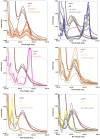Antioxidant, antibacterial, and catalytic performance of biosynthesized silver nanoparticles of Rhus javanica, Rumex hastatus, and Callistemon viminalis
- PMID: 35197757
- PMCID: PMC8848139
- DOI: 10.1016/j.sjbs.2021.10.016
Antioxidant, antibacterial, and catalytic performance of biosynthesized silver nanoparticles of Rhus javanica, Rumex hastatus, and Callistemon viminalis
Abstract
Rhus javanica (Anacardiaceae) containing abundant glucopyranosidal constituents, is traditionally used to treat gastric and duodenal ulcer, dysentery, and diarrhea. Rumex hastatus (Polygonaceae) widely distributed in Pakistan, has traditional importance in treating wound healing, jaundice, rheumatism, and skin diseases. Callistemon viminalis (Myrtaceae), a rich source of essential oils, saponins, triterpenoids, phloroglucinols, and flavonoids is used in industries, perfumes, nutrition, and cosmetics. Taking the importance of the subject plants, this study is designed to synthesize silver nanoparticles via aqueous extracts of R. javanica (RJAgNPs), R. hastatus (RHAgNPs), and C. viminalis (CVAgNPs). Synthesis, surface, and sizes of silver nanoparticles (AgNPs) were confirmed using spectroscopic techniques including ultraviolet-visible (UV-Vis), Fourier transform-infrared (FT-IR), and scanning electron microscopy (SEM). AgNPs were produced in ratios 1:15, 1:16, and 1:9 and inferred via appearance of a sharp surface plasmon resonance (SPR) absorption peak (400-435 nm), which represented well-defined, stable, and spherical AgNPs. From SEM analysis, the sizes of RJAgNPs, RHAgNPs, and CVAgNPs were found to be 67 nm, 61 nm, and 55 nm, respectively. The synthesized AgNPs exhibited potential free radical scavenging, antibacterial, and catalytic properties in degradation of dyes including Congo red, methylene blue, methyl orange, rhodamine B, ortho and para-nitrophenols, and several food colours. Hence, the subject AgNPs in the current study might display promising role in drug development and remediation of environmental/industrial effluents.
Keywords: AgNPs; Antibacterial; Callistemon viminalis; Rhodamine B; Rhus javanica; Rumex hastatus.
© 2021 The Author(s).
Conflict of interest statement
The authors declare that they have no known competing financial interests or personal relationships that could have appeared to influence the work reported in this paper.
Figures










References
-
- Ahmad S., Ullah F., Sadiq A., Ayaz M., Imran M., Ali I., Zeb A., Ullah F., Shah M.R. Chemical composition, antioxidant and anticholinesterase potentials of essential oil of Rumex hastatus D. Don collected from the North West of Pakistan. BMC Complement. Altern. Med. 2016;16:29. doi: 10.1186/s12906-016-0998-z. - DOI - PMC - PubMed
-
- ElMitwalli O.S., Barakat O.A., Daoud R.M., Akhtar S., Henari F.Z. Green synthesis of gold nanoparticles using cinnamon bark extract, characterization, and fluorescence activity in Au/eosin Y assemblies. J. Nanoparticle Res. 2020;22:309. doi: 10.1007/s11051-020-04983-8. - DOI
-
- Erci F., Cakir-Koc R., Isildak I. Green synthesis of silver nanoparticles using Thymbra spicata L. var. spicata (zahter) aqueous leaf extract and evaluation of their morphology-dependent antibacterial and cytotoxic activity. Artif. Cells Nanomed. Biotechnol. 2018;46(sup1):150–158. doi: 10.1080/21691401.2017.1415917. - DOI - PubMed
LinkOut - more resources
Full Text Sources

